WUZHEN, CHINA - On a Mid-Autumn Festival morning, the residents of this ancient Yangtze River Delta water town are up early getting ready to welcome the hordes of weekend tourists.
Workmen are cleaning the town’s ponds which just a few weeks earlier were flush with massive pink lotus flowers. Now, just a few remain — they stick out from the giant elephant ear-like leaves surrounding them trying to catch the last of the summer rays.
The thick ivy covering the stone and wooden structures that make up this 1,300-year-old village are beginning to blush with autumn hues.
The town’s famed boatmen, who later will take tourists on a cruise along the lazy Xizhi Canal — it divides Wuzhen into East and West sections — must first deliver inventory to the shops and restaurants that occupy the town’s cobbled main street known as Xizha.
Young lovers are up early, too, hoping to take romantic pictures before the streets become too crowded — the women strike a sultry pose while sitting on one of the famous stone bridges that arch the canal.
Shopkeepers arrive and begin removing large wooden planks that have served as doors in Wuzhen for centuries. Others begin preparing food for the hungry throngs — steamed rice cakes filled with red bean paste and fried shredded turnip are the most popular dishes, it seems.
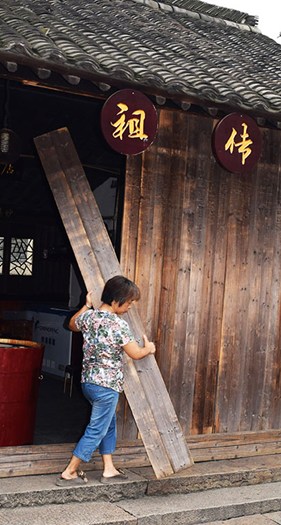
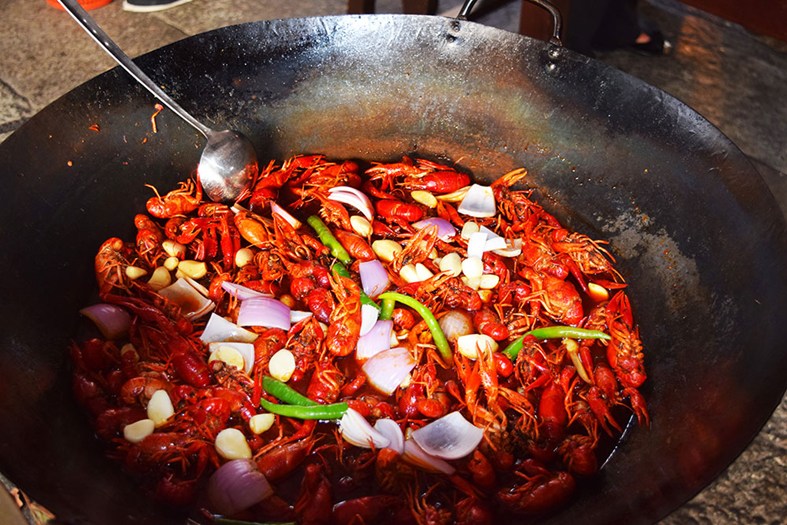
Left: Wooden planks serve as doors. Right: The local cuisine is hot and spicy.
A group of Western tourists linger over their bowls of steaming congee (rice porridge) at one of the home stay lodgings on Xizha Street. They’ll soon start touring this literary town where some of China’s legendary writers and philosophers, including Kong Lingjing, a descendant of Confucius — a memorial to him stands on Xizha Street — once lived.
Home stays are the most popular form of accommodation in Wuzhen. Domestic tourists — most come from nearby Shanghai, a two hour drive away — like to occupy the old, refurbished homes that cling to the banks of the canal on weekends and holidays so they can experience the water town lifestyle of their ancestors.
There are many water towns in this area — they sprung up when the Grand Canal was built linking Beijing with Hangzhou, the nearby retirement retreat for many bureaucrats in the earliest Chinese dynasties. The oldest parts of the Grand Canal, the longest of its kind in the world, were started in the 5th Century BC and were completed during the Sui Dynasty between 581 and 618 AD. The waters of Wuzhen’s Xizhi River pour into the Grand Canal, which remains a major artery for barges hauling goods from southern China to the capital.
Wuzhen is listed as the second most important water town after 900-year-old Zhouzhuang but after visiting both on my trips to China, my vote goes to Wuzhen as the best.
Its compact size and active artisan lifestyle that hasn’t changed much over the centuries makes it a living museum and gives visitors a true glimpse into ancient Chinese life in a place that seems frozen in time.
Translated, the name Wuzhen means “Black (Wu) Town (Zhen)” and ironically it comes alive when darkness falls — Western music and laughter pour out of the clubs gathered along what’s known locally as “Bar Street” on the opposite side of the Tongji Stone Bridge.
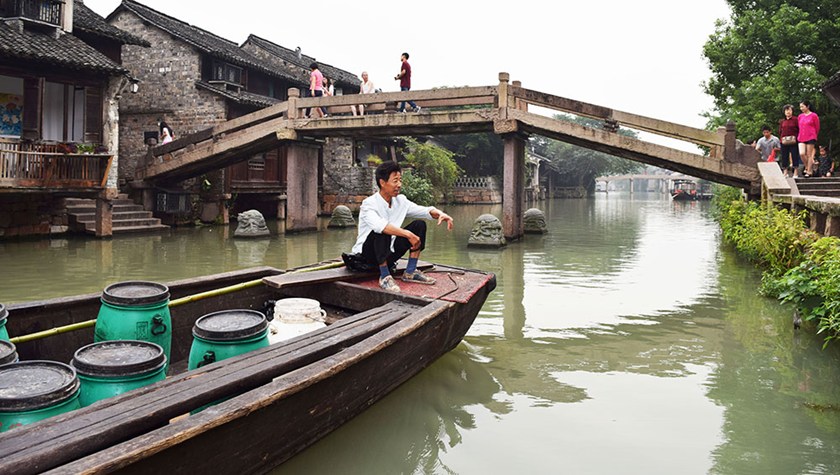
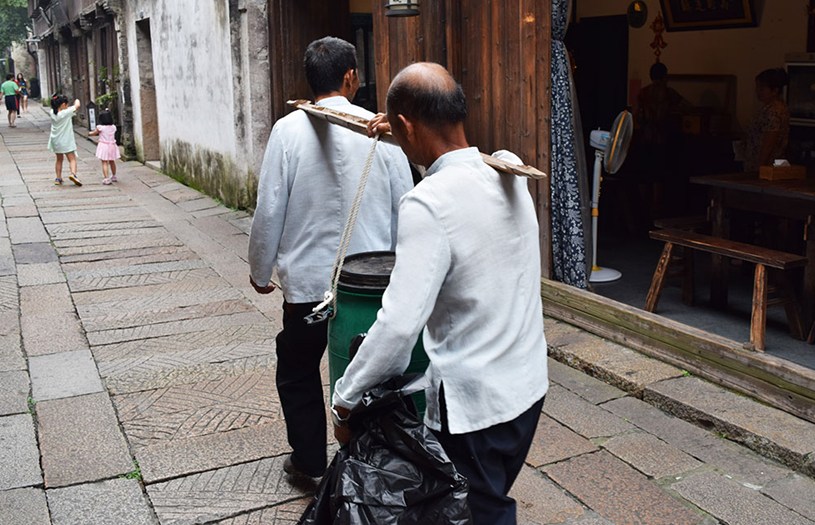
Above: The ancient traditions are kept alive in this lovely village.
The tallest structure in Wuzhen is the multi-tiered White Lotus Pagoda, a temple that looks out on the Grand Canal. Beside the temple is China’s mythical Stone Boat, where worshippers come to pray and chant.
Many of the homes here were once owned by famed writers and poets like Zhao Ming, Shen Ping and Mao Dun, the most famous of Wuzhen’s writers.
Mao Dun wrote a book entitled ‘The Shop of the Lin Family’ which chronicled his childhood here — it’s still one of the most popular books ever written in China. His boyhood home, which was purchased by his father in 1885, is now a museum and stands as a monument to his memory.
Another fascinating museum in Wuzhen is the Jiangnan Furniture Hall. Traditional pieces dating back to the town’s earliest days are displayed with mannequins dressed in period costumes adding to the experience.
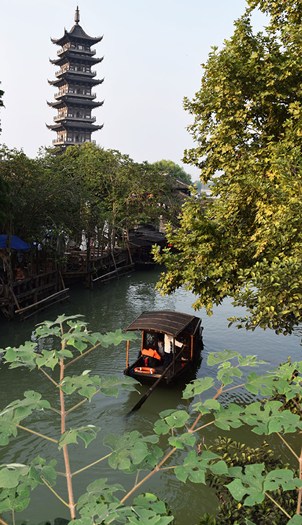
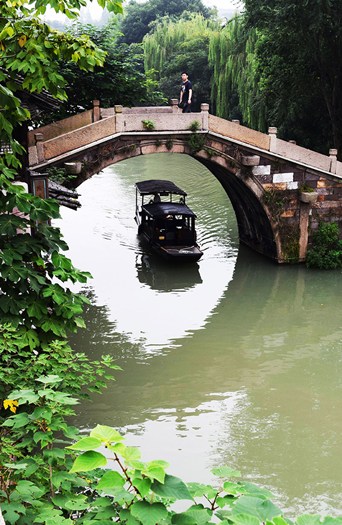
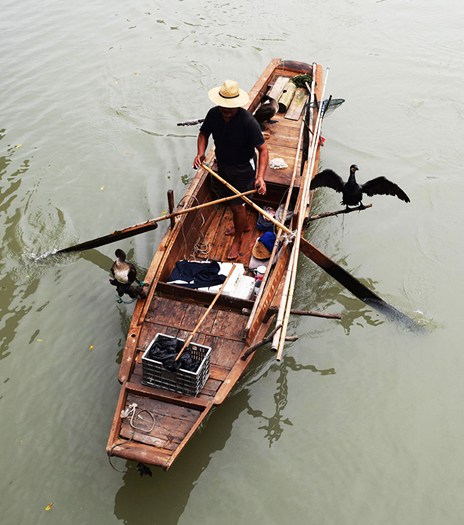
Above: Traditional boats are used to transfer goods and people and to hunt for fish.
While the much larger nearby cities of Suzhou and Hangzhou are recognized as the silk capitals of China, other water towns also produced the delicate material and Wuzhen was no exception. At the Yida Silk Workshop, which dates back to Qing Dynasty (circa 1875), you can see weavers produce the town’s famous Wu brocade and purchase some of the reasonably priced items to take home.
Outdoor shows and concerts are held in the Old Town Square and a new 1,200 seat theatre has just opened at the entrance to the historic area.
People gather in tea houses bunched along the canal and sip chrysanthemum tea while watching the small wooden boats take tourists on a leisurely ride. Wuzhen is noted for its sweets and pastries and one slice of a delicious pink cake called Dingsheng tells me why. The tea houses also serve a wine called Sanbai and the locals get louder with each sip.
Some of the artisans working in dusty shops on main street look like they’re as old as the town and eagerly invite strangers in to watch them turn bamboo sticks into cups and other useful household objects.
There are more than 30 stone bridges in tiny Wuzhen, the most famous of which is the “Bridge in Bridge” — twin structures that lead people to Shenglian Square where the giant pagoda and Bar Street are located.
With the setting sun dancing on the calm waters of the canal, I sit on one of the twin bridges admiring the view and enjoying the merriment of young people headed for dinner and the clubs on Bar Street.
Wuzhen may be one of the oldest towns in China but the young people who come here to party each night are injecting new life into it.
Information
Wuzhen is located an hour by car from Shanghai. / Accommodation ranges from historic water home stays along the canal to budget hostels and 5-star hotels. The Wuzhen Clubhouse on main street is a member of the Small Luxury Hotels of the World and offers visitors a real glimpse into what life was like in this town’s earliest days. / Tour East Holidays has many tours that include visits to Shanghai and can customize a visit to Wuzhen. Contact Tour East at http://www.toureast.com / For more tourist information on China, go to http://www.tourismchina.org
About the Author
Marc Atchison is a veteran journalist and a seasoned traveller with more than 20 years of travel writing experience. As the former Travel Editor of the Toronto Star, Canada's largest newspaper, and now Editor-in-Chief and Senior Writer for TraveLife magazine (Canada) and travelife.ca, Marc has been to over 100 countries in the world. Japan is one of his favorite destinations and he's been there on numerous occasions.